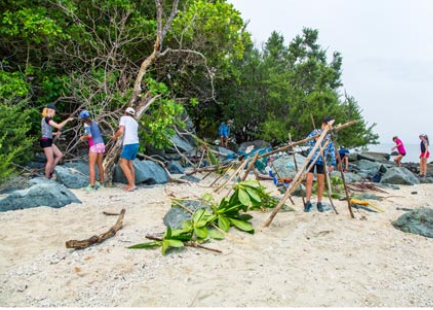
Hi I am Elle Gentle I am a second-year student studying a BA (Hons) Working and Teaching in the Early Years, currently researching the benefits of children being allowed to take risks. Has health and safety gone too far and are we restricting their development if we wrap them up in cotton wool?

Over the years I have spent a lot of time working abroad in places such as Egypt and Malaysia looking after children as a Kid’s Club representative, providing various activities and a range of arts and crafts for all different ages. However, for this article I wanted to focus my attention on the work that I did in Malaysia on a small island resort called Sea Gypsy Village Resort. The island where the resort is located is called Pulau Sibu Besar and I have worked there on and off for about three years. As described on their website, the place is “A resort surrounded by jungle with a beautiful, safe, secluded, virtually private sandy beach. Perfect for families and couples who are looking to escape the stress of the city. Transport yourself back to a time before phones and email, engage in a digital detox to rediscover the value of time spent together”. https://www.siburesort.com/

I think one of the reasons why I have fallen in love with this place is this last point, the digital detox. I have been able to see families coming together, children playing outside, running around and exploring both jungle and ocean. As for the parents, they are able to relax as they know that their children are safe on this secluded island. This is something so often lost to the industrialised world as our children become increasingly surrounded by technology. Whilst there are many benefits to this technology, are our younger generations playing outside like we used to do? The benefits of outside play are endless, as stated by Greenfield (2004, cited in Little and Wyver, 2008: 36) ‘the risks and challenges of being outdoors provide rich opportunities for learning, problem-solving and developing social competence’.

The resort also provides educational school trips several times a year. From the minute the children set foot on the island, they take part in games and tasks that promote teamwork, leadership skills, problem solving and survival skills. The activities can include anything from making bandanas to creating team chants, from gutting fish to making shelters and from orienteering to beach competitions. The children are constantly surprised by what they are capable of and go home exhausted and elated. The necessary risks assessments are completed by the resort and standard operating procedures are put in place to ensure the safety of all children. One of the main activities which could be described as risky, is the Survivor game. The children are taught basic survival skills such as making fires with flints, building shelters from natural materials and even how to gut fish. Once these skills are taught, we take them to a small deserted island and make out as if they will be staying there overnight. The children must work as a team, gather the resources needed, put together a shelter and make a fire. The skills that the children develop from this are incredible and include resourcefulness, team-work, perseverance, problem solving. So much learning happens from such a hands-on experience. According to Craig (2007, cited in McArdle et al, 2013: 249) ‘Confidence to face up to new and challenging situations is a condition that, we suggest, encourages resilience’. Could we be doing more in the UK to facilitate these types of experiences?
References
LITTLE, H. and WYER, S., 2008. Outdoor play. Australian Journal of Early Childhood. 33 (2), pp. 33-40. Available from: https://doi.org/10.1177/183693910803300206 [Accessed 31 January 2020].
MCARDLE, K., HARRISON, T. and HARRISON, D., 2013. Does a nurturing approach that uses an outdoor play environment build resilience in children from a challenge background? Journal of Adventure Education and Outdoor Learning. 13 (3), pp 238-254. Available from: https://doi.org/10.1080/14729679.2013.776862 [Accessed 31 January 2020].
